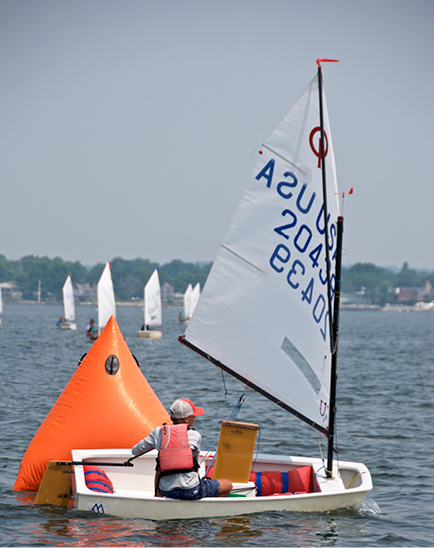Once you get good at using crew weight and sail trim for turning your boat, you can think much more about the shape of the course that you steer around marks. When it comes to carving turns, I imagine that sailing is a lot like racing a car. Both sailors and race car drivers want to travel the shortest distance possible, but they can’t cut any corner too sharply or they’ll lose a lot of speed. Therefore, both steer turns that are a compromise between the fastest speed and the shortest distance.
One thing that’s certain about good mark roundings is that you must think about each turn before you get there. You can’t approach the windward mark thinking you will do a bearaway set, for example, and then switch at the last second to a jibe set. Well, you can try that, but chances are it won’t be very fast or smooth. Many factors influence the best path for you to steer around any mark. These include things like:
• The weight and size of your boat. Bigger, heavier boats have to make a much wider and slower turn in order to maintain speed.
• The wind velocity. In light air, for example, you have to turn more slowly and you shouldn’t do a jibe set. In breeze, you must allow time for sailhandling maneuvers.
• The presence of other boats. The more traffic there is, the more this will disrupt your ideal turn.

Round every mark close enough to touch it, like Opti racer Maxwell Beaven. © Rick Bannerot/OntheFlyPhoto.net
If possible, you should always carve a ‘strategic’ turn around the mark. A strategic turn is basically your proper course. It’s the course you steer when there are no other boats around and your only concern is getting to the finish line as quickly as possible.
A ‘tactical’ turn, on the other hand, is a rounding you make to beat the boats around you. Any time you have to maneuver relative to boats nearby, you lose distance to the rest of the fleet – so when you are making your turn, minimize boat-on-boat tactics and maximize your progress to the next mark.
Like other maneuvers, a mark rounding will usually go better if you come into it with speed. Speed helps you carve a better turn, gives you more options, and usually means you come out of the mark- rounding maneuver going faster.
For example, when approaching the windward mark it’s usually better to be one boatlength over the starboard layline than one length below it. Even if both boats can make it around the mark, the one that overstood slightly will have much more speed and therefore a better chance for a good rounding.
Once you begin turning around the mark, try to use as little rudder as possible. When you do turn the rudder, don’t change its angle too much. The best way to maintain your speed is by turning in a constant radius. Of course, you will never be able to do this for an entire mark rounding, but if you hold the rudder steady for an extra couple of seconds it will make a difference. ■
This article originally appeared in David Dellenbaugh’s Speed & Smarts, The newsletter of how-to tips for racing sailors. If you want to sail faster and smarter, log onto SpeedandSmarts.com.
A resident of Easton, CT, Dellenbaugh was tactician and starting helmsman for America3’s successful defense of the America’s Cup in 1992. He’s a Lightning World Champion, two-time Congressional Cup winner, seven-time Thistle National Champion, two-time winner of the Canada’s Cup, three-time Prince of Wales U.S. Match Racing Champion, and a winner of the U.S. Team Racing Championships for the Hinman Trophy.
